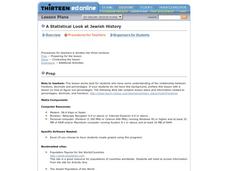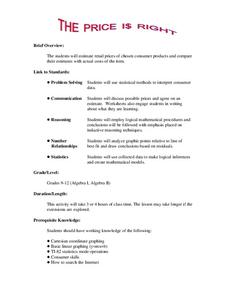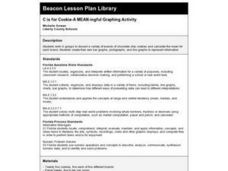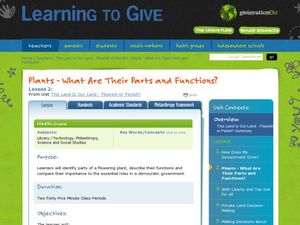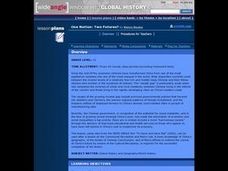Curated OER
A Statistical Look at Jewish History
Students complete their examination over the Jewish Diaspora. Using population figures, they discover the importance of percentages in exploring trends. They use their own ethnic group and determine how it is represented in the United...
Curated OER
Collecting Data and Graphing
Students practice collecting and graphing data using interlocking cubes. In this graphing lesson, partners count cubes and graph them. They also use a meter stick to measure arm span and height then compare the results with the class as...
Curated OER
The Price Is Right
Students create a list of products with estimated prices. In this algebra instructional activity, students learn to write equations using variables. They match their created list with that of actual products and compare their...
Curated OER
Candy Cane Chemistry
Fourth graders, in groups, examine the effect of heat on bonding forces by doing laboratory work.
Curated OER
C is for Cookie-A MEAN-ingful Graphing Activity
Third graders, in groups, dissect a variety of brands of chocolate chip cookies and calculate the mean for each brand. They create their own bar graphs, pictographs, and line graphs to represent information.
Curated OER
What Do I Write About?
Second graders write as essay describing the cooperative group drawing they made or describing the process to draw a group picture.
Curated OER
Get to Know Your City
Third graders research the history of their home city and how it's development was influenced by different groups of people. They present their research information to the class.
Curated OER
Plants- What Are Their Parts and Functions?
Students learn about plants. In this plant function lesson plan, students label the parts of a plant and their functions. Students work in small groups to create three simile statements to relate to the function of essential plant parts....
Curated OER
Introduction to Archaeology
Students view a PowerPoint presentation called, Archaeological Terms then discuss the job of an archaeologist and new vocabulary. They view the teacher made "artifact grid" and photograph the grid from different angles. They work in...
Curated OER
Human Rights in the Philippines
Students examine the meaning of human rights under the United Nations system, in the U.S., and the Philippines. They conduct research, discuss the concepts in groups, and conduct a debate on the human rights situation post Marcos...
Curated OER
The People of Kansas: Where Did They Come From and Why Did They Come?
Pupils research and discuss the reasons why early settlers emigrated to Kansas. They, in groups, analyze census district reports from the 1850's and then identify the advantages and disadvantages of using this information as research.
Curated OER
Too Much Sun, Not Much Fun
Sixth graders, in groups, research the dangers of too much sun. They are to create and present posters they made showing the information of what happens when one is exposed to too much sun and how to protect your skin from the sun.
Curated OER
Identifying Seasonal Animal Behaviors
Students discuss seasonal behavior of different animals. They participate in group activities and identify animals. They also examine the changes in seasons and how animals act differently in different seasons.
Curated OER
China: One Nation: Two Futures
Tenth graders explore the evolution of Chinese communism to its present export-driven economy. Working in groups, they examine various articles about reforms in Chinese society. They write essays about the impact of political reform on...
Curated OER
Native American Legends
Students work together in groups to research a Native American legend. They present the information they gathered in a format they chose. They write their own legend based on their research.
Curated OER
Global Warming
Middle schoolers examine how human produced emissions of carbon dioxide contribute to global warming. Using the internet, they research the future effects of global warming on the Earth. In groups, they discover ways to reduce daily...
Curated OER
What are Mammals?
Pupils differentiate between wild and tame animals, explain how to classify mammals into groups based on common charactertistics and comprehend the values of zoos. They listen as the teacher reads Psalm 50:10 and explains that all of the...
Curated OER
Nutrition
Fourth graders, with a partner, design, construct and create a title card with a picture and a fact card based on one of the food groups in the Nutrition Pyramid. They determine the nutritional value of foods in his/her diet and design...
Curated OER
Changing Circumstances, Changing U.S. Foreign Policy
Students examine how relationships between countries change overtime. They identify the factors that play a role in altering the relationships and contribute to U.S. foreign policy toward their country of research. Groups conduct their...
Curated OER
Tell Me About It: What is Design? Creating a Design Workshop Part 2
Students create a workshop on basic design to introduce the concept to elementary students. In this design workshop instructional activity, students view two videos that provide basic design concepts. After discussing the concepts as a...
Curated OER
Westward Ho!
Young scholars participate in an Oregon Trail simulation in order to learn the hardships that the emigrating settlers faced. In this U.S. history lesson, students are required to work as a team and use the internet to research a final...
Curated OER
Which Objects Will Sink or Float?
First graders work in cooperative groups and utilize a variety of materials to test objects ability to sink or float. In this sink or float lesson, 1st graders discover why some object sink and others float. Students will graph results...
Curated OER
Introduction to Bats
Students read about bats and discuss what they learn. In this bats lesson, students read stories about bats and discuss what they learned. Students work in groups to brainstorm what they know about bats and make a list of at...
Curated OER
What is the Essential Gandhi?
Seventh graders explore the essence of Gandhi's teachings. In this nonviolent protest lesson, 7th graders select service projects based on the teachings of Gandhi.
